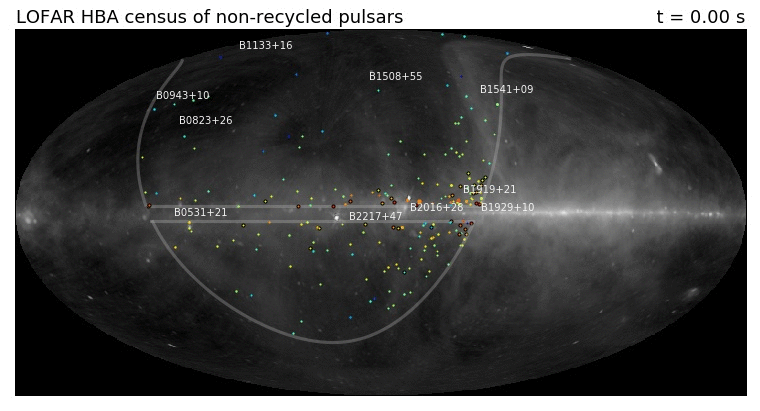Daily Image
09-09-2016LOFAR's view on pulsar sky
| Submitter: | Anna Bilous & Vlad Kondratiev |
| Description: | Imagine you are a sentient alien creature with a pair of superb radio eyes, capable of discerning even the most minute splashes of radio emission... how would the night sky look to you? The image above may give a clue to that. On top of the diffuse black-and-white Galactic background, the swarm of color dots provides a one-second glimpse into the life of 158 northern pulsars, with the course of time slowed down by a factor of 10. These pulsars were observed within the LOFAR Pulsar HBA Census -- a large project which aims at creating the first uniform low-frequency (110-188 MHz) portrait of all known non-recycled pulsars in certain regions of the sky. All 196 pulsars with well-known positions within the grey lines(*) were observed, regardless of their estimated brightness and scattering level. Only 38 of those pulsars escaped detection (still dots with black edges). The first paper in the census series (Bilous et al. 2016) describes the general set-up of the project, and presents the first basic results: calibrated average pulse profiles (reflected by the size of the dot varying with time) and the dispersion measures (DM, shown as color, increasing from blue to red). DM is a quantity proportional to the amount of matter in the interstellar medium along a given line of sight. Because of the advantageous frequency position, the census observations yielded DMs that are 10 times more precise, on average, than those in the standard ATNF pulsar catalogue. The obtained flux density values helped to constrain the shape of pulsar spectra. For 48 of the census pulsars, spectral fits were published for the first time. The observations within the LOFAR Pulsar HBA census resulted in a unique data set, useful for studying both pulsar emission and the interstellar medium. Data analysis is continuing, so watch this space for many more interesting results in the future. (*) The horizontal gray lines indicate the plane of our galaxy. The curved gray line indicates the part of the sky (i.e. most of the Northern hemisphere) that can be observed by LOFAR. |
| Copyright: | Anna Bilous |
| Tweet |  |
